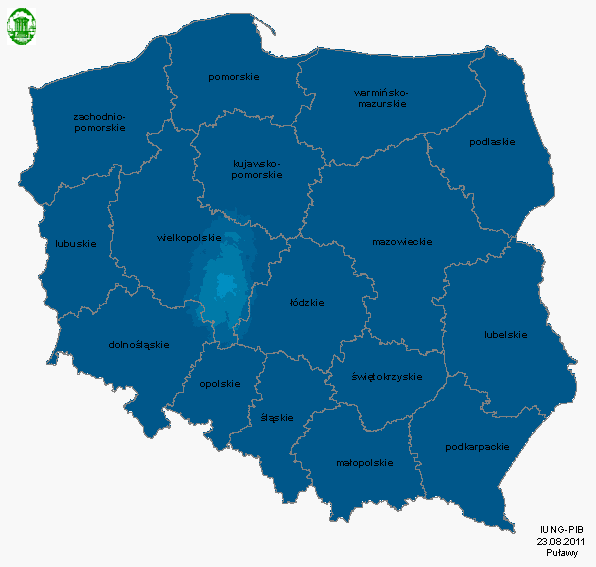ARCHIVES (2011)
Do roku 2016 raport oznaczony numerem 1 był tworzony za okres od 1 kwietnia do 31 maja. Od roku 2017 analizy są wykonywane o dekadę wcześniej czyli 1 raport oznacza okres od 21 marca do 20 maja
Communication report regarding the incidences of drought conditions in Poland
Year: 2011; period: 10 (1.VII - 31.VIII)
In the tenth reporting period, i.e. from 1 July to 31 August 2011, we can find no threat of agricultural drought conditions in Poland.
In the tenth reporting period for the area of Poland, the average climatic water balance (CWB), compared to the previous period has not changed. CWB values in Poland are still much higher than the critical value. In large areas of the country, they are positive. Negative values are still only found in the southern part of the Wielkopolskie Voivodeship.
In the current sixty-day period, demand for water has been much smaller for all the crops than in June and July. The air temperature in July varied. The coldest was in the western and south-western parts of the country (16-17.5°C), while the warmest was in the eastern parts of Poland (18-19°C).
The first ten days of August were the warmest in the southern Wielkopolska Lowlands (18-19°C). In other areas of Poland the air temperature was slightly lower at 17-18°C. In the second ten-day period of August, the southern Wielkopolska Lowland was also the warmest area, although the temperature was already slightly higher at 19-19.5°C than the previous month. Similar hotter conditions also occurred in the Dolnośląskie Voivodeship and the Sandomierz Basin. In other areas of central and southern Poland were also warm, from 18 to 19°C. The coldest areas were in northern Poland, 16-18°C. In the third ten-day period of August, Poland was divided into two parts, warmer in southern areas whilst in the north it was colder. In the middle belt of the country the temperature was around 19°C in the south grew to reach over 20°C in the Beskid Mountains, in the north it continued to decline, reaching 17°C in the Pomorski and Mazury Lake District.
The precipitation in July was very widespread over a large area of the country. The greatest rainfall occurred in the east and in the narrow strip on the western edge of Poland, from 160 to 300 mm, slightly smaller precipitation, from 100 to 160 mm occurred in the rest of the country. In the first ten-day period of August, the greatest precipitation occurred in the Suwalki region (26-33 mm) and gradually decreased in a south-westerly direction towards the Ślaskie Lowlands, reaching values of 10 to 16 mm. In the second ten-day period of August, rainfall over a large area of the country ranged from 15 to 45 mm, while the lowest (5 to 15 mm) occurred in the south-eastern part of Poland. In the third decade of August in terms of rainfall, Poland was very diverse. In the south-eastern part of the country rainfall did not occur. The eastern areas were very low (up to 10 mm). In a broad belt running from north to south the rainfall ranged from 10 to 25 mm, and in the west of the country from 25 to 70 mm.
Meteorological conditions in the last ten days of August definitely improved, especially in the south-eastern Polish territories. The air temperature in the southern part of the country was high and rainfall was low which made it possible to carry out the delayed harvest of cereals. A much worse situation occurred in the northern part of the country due to high precipitation and low air temperatures which continues to hamper harvesting in these areas.
Reports
- Report 13 (1.VIII - 30.IX)
- Report 12 (21.VII - 20.IX)
- Report 11 (11.VII - 10.IX)
- Report 10 (1.VII - 31.VIII)
- Report 09 (21.VI - 20.VIII)
- Report 08 (11.VI - 10.VIII)
- Report 07 (1.VI - 31.VII)
- Report 06 (21.V - 20.VII)
- Report 05 (11.V - 10.VII) +
- Report 04 (1.V - 30.VI) +
- Report 03 (21.IV - 20.VI) +
- Report 02 (11.IV - 10.VI) +
- Report 01 (1.IV - 31.V) +





